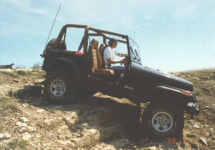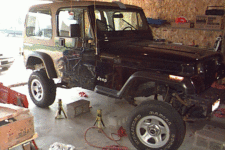Once you start wheeling in a stock vehicle, it doesn’t take long before you start wanting more ground clearance. There are a number of ways to do this on a leaf-sprung vehicle like a YJ, including body lifts, shackle lifts, spring lifts, and coil conversions such as Warn’s [now discontinued]. However, for the best combination of ride quality, ground clearance, and cost, the only option is a spring-over-axle (SOA) conversion.
For those not familiar with SOA, the concept is pretty simple. Most Jeeps, including CJ’s and YJ’s, come from the factory with the axles sitting on top of the suspension leaves. An SOA lift takes the axle off the top of the springs and reattaches it underneath the springs. The amount of lift gained is the sum of the axle tube diameter, the spring pack thickness, and both the old and new spring perches. On a YJ, this generally amounts to around 5.5″. Because the lift itself potentially uses all stock parts, cost is kept to a minimum. Because it uses your stock, mostly-flat springs, the factory ride quality is maintained. Of course, adding 5.5″ of height requires modifying the steering, drivelines, and brakes, so putting this lift on a stock vehicle is a bit more involved than it may first sound.
After listening to the Jeep gurus on the Jeep Offroad and JeepTech mailing lists for a couple years, I was finally convinced that SOA was the route I wanted to take when the time came to lift my ’95 YJ. In the words of sage Jeeping guru and SOA poster boy Jefe, “Eventually, every serious rock crawler will go spring over.” While there aren’t that many rocks near Lincoln, NE, that is the style of wheeling I like best. I saved my pennies for over a year, waiting for the time when I could join the big dogs off road. That time finally came in April of 1999.
As mentioned earlier, there are several other things you need to consider when lifting a stock YJ 5.5″. The first is driveline angles. A YJ’s rear driveshaft is short enough as it is, and raising the front end of it 5.5″ makes for a pretty severe driveline angle. While I know people who have kept their OEM-style driveshaft (lengthened, of course) after going SOA, you’re much better off if you reduce the driveshaft angle. The first thing to do is get rid of that silly slip yoke on the rear of the NP231 transfer case. Not only does it shorten your driveshaft by almost 4″, it also allows the entire output shaft to fall out if the driveshaft somehow comes loose from the pinion. This is a Bad Thing. Everybody and their dog seems to make a slip yoke eliminator (SYE) kit these days. I won’t describe most of them in detail here, but you want the low-down on several different kits, hit me up in the comment section below. I chose to go with the Currie SYE kit
because it was more reliable than the Rubicon Express kit, yet considerably cheaper than most of the other kits that included beefed-up output shafts. The Currie unit includes a shortened stock shaft. It costs $510, $250 of which is refunded when you return your old output shaft to them.
Another way to improve driveline angles is to use a CV (constant velocity, or double-cardan) style rear driveshaft. This requires you to point the pinion from your rear axle directly toward your t-case output yoke, which is no problem during an SOA conversion since you’ll be welding on new spring perches anyway. Tom Wood, formerly of Six States Distributors and now on his own at Tom Wood’s Custom Driveshafts, is the man to talk to about drive shaft specifics. A top of the line, long-travel rear shaft for this application will cost $275, including shipping.
The second major consideration is steering. Putting your drag link at a steep angle is never a good thing. To reduce the effects of bump steer, you want to reduce the drag link angle and still keep it at the same angle as the track bar. One solution is to get a dropped pitman arm (a stock ZJ arm works well on the YJ) and a track bar relocation bracket. I got both from Rubicon Express for $60 and $18, respectively.
A third consideration is brake lines. Your stock lines won’t be anywhere near long enough to reach your newly-relocated axles. Not only does SOA give you more height any most commercial lifts, it also allows for more axle droop. Good luck finding pre-made brake lines that are long enough! One solution is to use somewhat longer soft brake lines and then relocate the hard lines lower on the frame so they’ll reach your axle. Other reports claim that front brake lines from a ’79 Ford F-150 will fit on a YJ. Another option, which I’ve decided to go with, is to
get custom-length, make-it-yourself braided stainless steel lines from Earl’s Performance Products. One rule of thumb is to get lines that are 8-10″ or so longer than the stock lines to make sure you’ve got plenty of slack to handle the increased wheel travel. Due to the size of my lift and my initial ignorance on the topic, this was by far the biggest headache of the entire project. I know much more now than I did when I started.
Of course, an SOA YJ would look silly running the stock 28″ tires, so I’ll include five new 33×9.50 BFG MT’s in the cost of my upgrade. I found them for $716.94 (including tax, mount, balance & road hazard warranty) from Sam’s Club. Since this is my daily driver and we get a fair amount of adverse weather in Nebraska, I found a local tire shop (Nebraska Tire) that would sipe them for $10-15 each. I haven’t had this done, and may not, since it would probably void my road hazard warranty. That’s significant, since I destroyed two tires last year.
-
Click here for the shopping list.
-
Click here for the basic instruction list that I followed.
-
Click here for the blow-by-blow story of the entire installation.
-
Click here for the before & after statistics.
-
Click here for the maiden voyage trail report.
In Closing
Special thanks go out to the following folks who loaned me their time and/or tools to help finish this project: Chuque Henry, Mark Vogel, John Hollingsworth, Justin Sanders, Conrad Vogel, Rick Buis, Jim Davis, Don Bishop, and Todd Reynolds. Many thanks also go to the contributors of the JeepOffRoad, SWBJeep, JeepTech, and Jeep-L mailing lists, without whom I would never have even known what SOA was.
If you still need convincing that SOA is the way to go, check out some other great SOA writeups by John Nutter, Larry Soo (Lars), Matt Osburn, and Chris Waterman.


